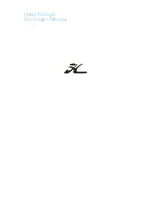
If your boat keeps going to the port (left) side, remove the boat and
loosen the U-bolts and/or the through bolts that clamp the roller
assemblies on the stern (back) section of the trailer. Force each
assembly to the right as if you were trying to turn the handlebars of
a bicycle. Hold each assembly in this turned position and retighten
the U-bolts and/or through bolts.
This repositioning of the roller assemblies should correct the mis-
alignment of the boat on your trailer. If your boat goes toward the
starboard (right) side, reverse the procedure.
Another common reason for boats not centering themselves is
putting the trailer too deep in the water, which does not allow the
trailer adequate time to center the boat. This is especially true on
roller style trailers.
Note: Make sure your trailer is not too deep in the water or the
boat will float over the rollers and be difficult to load and center.
BOARDING YOUR BOAT
Larger pleasure boats remain stable under most operating condi-
tions because of their beam, draft, and weight displacement.
However, the U.S. Coast Guard does require that a capacity plate
be affixed to all boats up to 20 feet long. This plate states the maxi-
mum load capacity. The plate shows persons and gear in pounds
the boat will handle safely under normal conditions. The U.S. Coast
Guard establishes these load capacity ratings. Overloading and
improper distribution of weight are significant causes of accidents.
Keep weight below maximum limits for safety in turbulent water.
Important: The presence of the capacity plate does not relieve the
boat operator from the responsibility of using common sense or
sound judgement. Turbulent waters and adverse weather condi-
tions reduce the maximum load capacity rating of the boat.
When loading your gear on board your boat, remember to distribute
the load evenly, keep the load low and do not overload. Always step
onto the boat, never jump! Have someone on the dock pass your
gear aboard. Secure all gear firmly so that it will not move or inter-
fere with operation of the boat.
The way your passengers are seated and gear stowed in the boat affects
your boat’s performance. Passengers should board the boat one at a
time and find a seat. Passengers should remain seated during loading of
gear to maintain an even trim. Distribute your passengers and gear so
that your boat is balanced side to side and front to rear (Figure 5.1).
Note: The swim platform is designed for weight loads up to
300 pounds on the H2O series. Exceeding this weight limit
could cause damage to your boat or personal injury. The swim
platform is not designed to carry personal watercraft.
5-6
DANGER:
Fuel leaking from any part of the fuel system can
lead to fire and explosion that can cause serious bodily injury or
death. Inspect system before refueling.
CORRECT
Balanced load: gives
m
a
x
i
mum
p
e
rf
o
rm
ance
IN
CORRECT
O
ve
r
load
f
o
rw
a
r
d: ca
u
ses
b
oa
t
t
o
"p
lo
w"
IN
CORRECT
O
ve
r
load a
ft
: ca
u
ses
b
oa
t
t
o
"p
o
rp
oise
"
Figure 5.1 Boat Loading
Summary of Contents for 2012 H2O Series
Page 15: ...1 7...
Page 16: ......
Page 20: ......
Page 75: ......
Page 83: ......
Page 89: ......
Page 90: ...WIRING SCHEMATICS 12 12 1 H2O INST PNL PIGTAIL...
Page 91: ...12 2 H20 INST PNL PIGTAIL...
Page 92: ...12 3 H20 DECK DISTRIBUTION HARNESS...
Page 93: ...12 4 H20 DECK DISTRIBUTION HARNESS...
Page 94: ...12 5 H2O HULL DISTRIBUTION HARNESS...
Page 95: ...12 6 H20 OPTIONAL AERATOR DECK HARNESS...
Page 96: ...12 7 H2O OPTIONAL AERATOR HULL HARNESS...
















































